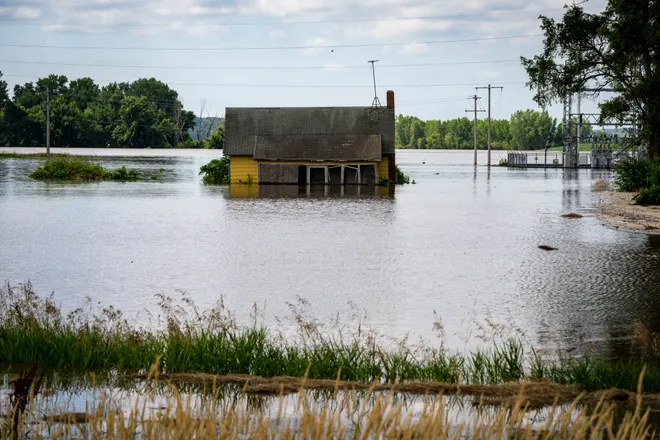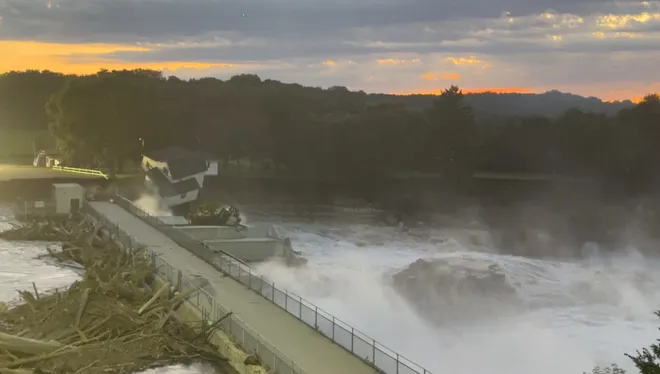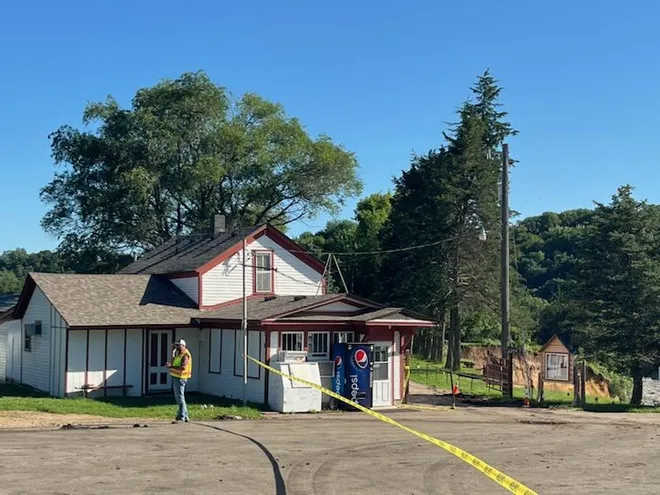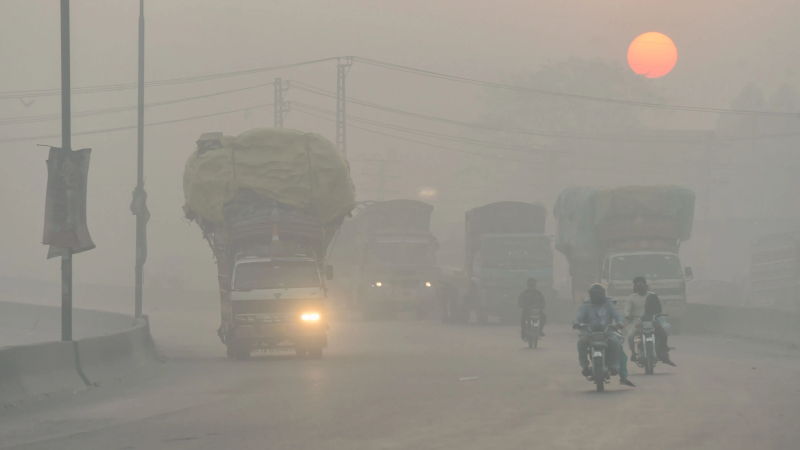Historic Midwest floods swamp rivers; it's so hot Lincoln melted
SMITHLAND, Iowa − Kathryn Barber stood on a closed section of Iowa Highway 141 marveling at the power of the Little Sioux River floodwaters.
Water covered all but the roof of a nearby home. Ball fields, which in drought years are desert dusty, looked like marinas with only foul poles and scoreboards above the water's surface. Barber and her husband, Bill, live on a nearby bluff and were nervously optimistic their home would survive the floods.
"It's very surreal," Barber said. "It’s hard when you’ve got to leave all your stuff behind. I’m not 100% confident."
Severe weather, thunderstorms and flooding have been blasting parts of Iowa, South Dakota, Minnesota, Michigan, Wisconsin and Nebraska for over a week. Major flooding has slammed more than a dozen rivers and nearby communities. One river has partially breached a Minnesota dam, swallowed up a nearby home and is threatening a highway bridge.
Swollen rivers feeding into the Mississippi River will cause major flooding in St. Paul, Minnesota, by week's end, AccuWeather said. A high pressure system locked in over parts of the southern U.S. will mean thunderstorms and possibly derechos − fierce, powerful, fast-moving and damaging storms − will continue this week and beyond, AccuWeather Lead Long-Range Meteorologist Paul Pastelok said. That means more surges of water and more flooding.
"There will be an increased threat of thunderstorm complexes, including potential derechos, from the north-central Plains and Midwest to the Great Lakes and Ohio Valley into early July," Pastelok said.

Developments:
∎ Hot and humid conditions were returning Wednesday across much of the nation's southern tier, the National Weather Service said. Highs are forecast in the mid- to upper 90s across the region, and low 100s are expected over portions of South Carolina and Georgia as well as the southern High Plains.
∎ Europe is also seeing record heat. Greece has shut down some of its ancient sites and warned tourists not to "take unnecessary risks" in the wake of the deaths across Europe during the heat wave.
∎ A 6-foot wax statue of President Abraham Lincoln installed outside a Washington, D.C., elementary school is slowly melting into a headless blob amid soaring temperatures. Sponsor CulturalDC, which said the wax congealing point is 140 degrees, said they removed the head to protect it while they figure out how to proceed.
Family loses home to Blue Earth River, cautiously watches ‘beloved’ cafe
The Hruska family has owned a small, white, colonial three-bedroom home and a nearby café for more than 50 years. People from across the globe flocked into the cafe to hear Jim Hruska’s stories and be transported to a time without technology, his son David Hruska told USA TODAY.
Their nearby home has been in the family for decades, giving them a riverfront view of the Blue Earth River. Tuesday night, it was swept away into the river after the Rapidan Dam partially failed, leaving David Hruska and his family speechless.
“You would never think in a million years our house would get washed away,” he said.
His sister, Jenny Barnes, was baking pies at the cafe, the Rapidan Dam Store, on Monday night when she overheard the Excel Energy substation explode and saw the water violently pull it into the river.

Hruska said his family and volunteers rushed into the home to grab as many things as they could before it collapsed around 9:30 p.m. Tuesday.
“Our store is in threat of dropping in and it's not as close as the house, but it's close enough where you're worried about it going,” he said.
That store is where people have traveled for its famous pies since it opened, he said. His parents created a guestbook in 1994 that has entries from the Soviet Union, Germany, Switzerland and others. Hruska worries about what will happen if the store has the same fate as his home.
“The house is replaceable,” Hruska said. “The Dam Store, you can't make another Dam Store because we're grandfathered in, there's no way to open the Dam Store as there are new regulations and policies.”

The city of Mankato said in a social media update the Blue Earth River is receding, spelling good news for the family's store, but their home is long gone.
Donations are slowly coming to the family after Hruska learned his insurance doesn’t cover mudslides.
-Krystal Nurse, USA TODAY
Water threatens bridge after Rapidan Dam partially fails
Minnesota's Rapidan Dam, which partially failed and allowed floodwaters to swamp a home Tuesday, saw "dramatic changes" in recent hours as floodwaters widened and deepened a channel flooding has cut around one side, local authorities said Wednesday.
Most of the Blue Earth River waters are now eluding the dam's gates and are racing through the channel. The waterflow has slowed slightly but remains too strong for emergency mitigation strategies and appears to be threatening the nearby Glacier Road Bridge, the Blue Earth County Sheriff's Office said in a social media post.
"The focus has shifted from the dam to the bridge given the recent erosion," the Sheriff's Office said. "We continue to work with downstream communities as the situation develops."

Forever home lost forever in South Dakota
In South Dakota, thousands in Minnehaha, Lincoln and Union counties alone have been affected by the flash floods, displacing some residents and inconveniencing others with water damage, destroying valuables and halting travel. Morgan Speichinger has lived on McCook Lake in North Sioux City since 2019. She thought it would be the forever home for her, her husband, two young children and two dogs. But the family had to leave their house behind Sunday evening when water levels rose in their neighborhood.
“This is where we were going to raise our kids, and we lost it,” Speichinger said. “We won’t be able to remediate until after they fix the roads. Our house is going to be destroyed by then. It’s going to be awful."
− Morgan Matzen and Kathryn Kovalenko, Sioux Falls Argus Leader
'Slow-moving disaster':Midwest rivers flood; Rapidan Dam threatened
Flooding of farmland could last for weeks
The flooding is being fueled by a weather pattern that began about two weeks ago, triggering rounds of storms that overwhelmed some areas with more than a month of rain in a few days, AccuWeather says. Some of the storms included heavy winds and hail.
Alex Sosnowski, senior meteorologist AccuWeather, said farmland in some areas of the Midwest could remain underwater for weeks.
Disclaimer: The copyright of this article belongs to the original author. Reposting this article is solely for the purpose of information dissemination and does not constitute any investment advice. If there is any infringement, please contact us immediately. We will make corrections or deletions as necessary. Thank you.



